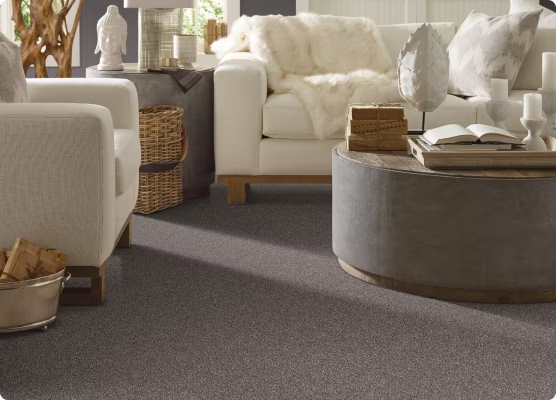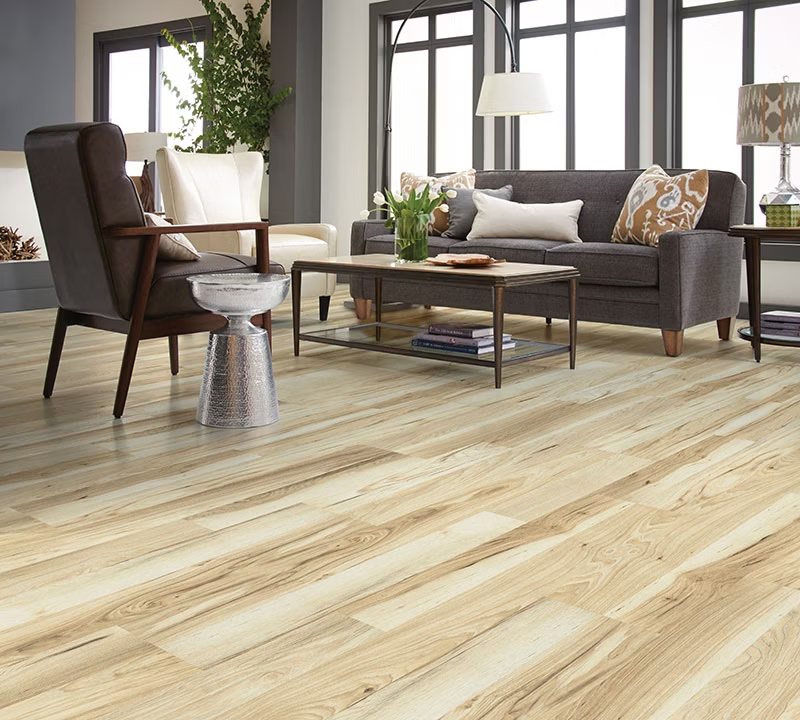The Benefits of Rubber Flooring: Installation, Durability, and More
Floor Coverings International® is one of North America’s most trusted rubber flooring installation companies for residential and commercial applications. Learn more about the different types of rubber flooring, how to keep your rubber floors clean, and more details to determine if this resilient flooring material is right for you!
Rubber Flooring Materials
Not all types of rubber flooring are identical. The category includes an array of rubberized floor coverings that vary in material composition and how they’re sold and installed. We tend to divide rubber flooring into two categories: rubber floor tiles and rubber floor rolls.
Rubber Flooring Tiles
Sometimes referred to as rubber floor squares, rubber tiles are pre-cut to specific dimensions and trimmed for the room’s specifications. These are commonly used in home gyms and exercise rooms and provide extreme resistance to impact, moisture, and heavy use. Interlocking rubber floor tiles are easy to install; we’ll look at installation details later.
Rubber Flooring Rolls
Also known as rolled rubber flooring, these large rolls are ideally suited for covering large areas and tend to be more common in commercial gyms and other expansive spaces. Like rubber floor squares, rolled rubber is the perfect match for exercise, a moist environment, and impact.
Rubber Tiles vs. Rubber Rolls
Both types of rubber flooring have advantages, making the decision largely dependent on the size of the room, the skill of the installation team, and how regularly you can commit to cleaning.
Rubber Tiles Pros and Cons
- Pros: Easier to install; can replace individual or sections of tiles; fits into irregular spaces.
- Cons: Costs the most per square foot; has visible seams; collects dirt and debris in seams; can shift with heavy use.
Rubber Rolls Pros and Cons
- Pros: Least expensive per square foot; seamless appearance; doesn’t collect debris; doesn’t shift; ideal for large spaces.
- Cons: Usually requires professional installation; requires more subfloor preparation; can’t fix individual sections; not suited for irregular spaces.
Your local flooring team will help you choose the right rubber floors for your space and use case.
Rubber Flooring Installation: What to Know
Installing rubber flooring is best left to professionals to maximize its many advantages. Even small issues like gaps between rubber tiles or the wrong adhesive underneath rubber rolls can cause problems in the long run, including subfloor damage.
Costs
How much does rubber floor installation cost? It varies significantly based on several factors, including the exact flooring material, the square footage of the room, and which adhesives are necessary. Your Design Associate will provide a detailed cost estimate before starting work so you know exactly how much your flooring project will cost.
Subfloor Preparation
Both types of flooring require careful prep, including cleaning the subfloor surface. Technicians clear dust, debris, and old adhesives to ensure a secure bond between the rubber flooring material and the installation surface. It’s also important to confirm the subfloor is level and completely dry; any moisture may cause the adhesive to fail.
Installing Rubber Floor Tiles
Interlocking tiles are the easiest to install, especially in small or odd-shaped spaces. Simply fit the tiles together, starting from one corner of the room and creating a straight line to the other. Most rubber flooring tiles don’t require adhesive.
Installing Rolled Rubber Flooring
Rolled rubber flooring is cumbersome, heavy, and considerably harder to install than rubber tile. This type of rubber flooring requires adhesive and must be carefully trimmed to fit the space. Experts use rubber mallets and special rollers to eliminate wrinkles and bubbles.
The Best Rubber Flooring Applications
Rubber flooring is good for a lot more than your home gym!
- Laundry room – Rubber flooring is inherently water resistant, which makes it ideal for protecting against leaks and spills. It’s also excellent for absorbing noise and dampening vibrations from running washers and dryers.
- Basements – Rubber flooring is a great option for homes prone to basement floods or high moisture levels. It also offsets the cold, hard feeling of concrete in basements.
- Playrooms – Kids play hard! Rubber flooring softens falls, dampens noise, and is easy to clean.
Its versatility in many rooms proves the benefits of rubber flooring: No matter where it’s installed, rubber flooring provides durability, a soft and non-slip surface, sound absorption, water resistance, and easy maintenance.
Not Sure About Rubber Flooring? Homeowners Love It!
And so do the expert rubber flooring installers at your local Floor Coverings International®. Trust our experienced Design Associates to provide expert recommendations on the right type of flooring for any space in your home. Look at rubber flooring samples from the convenience (and context) of your own space with our Mobile Showroom®, and see why customers love our fun and stress-free process. Start your project today; find your local flooring team to discuss your project, or schedule a consultation today.
Rubber flooring services vary by location. Check with your local Floor Coverings International® to confirm service and product availability.

Book An In-Home Consultation Today
Don’t settle for the limited inventories and lackluster customer service offered by other rubber flooring installers. Floor Coverings International® has perfected a better way to get the style and performance you want out of your new floors. We have the largest selection to choose from, and we bring the showroom to you for a hassle-free buying experience you won’t find at any other rubber flooring installation company. Rubber flooring will enhance your work or living space in ways you never imagined. Book an in-home consultation and see the possibilities for yourself by calling us today.
Book A Free Consultation
Tags



